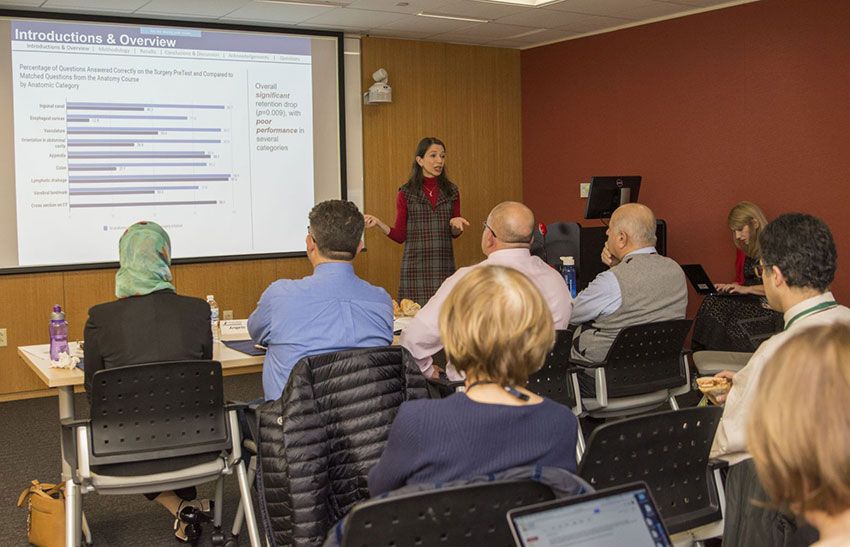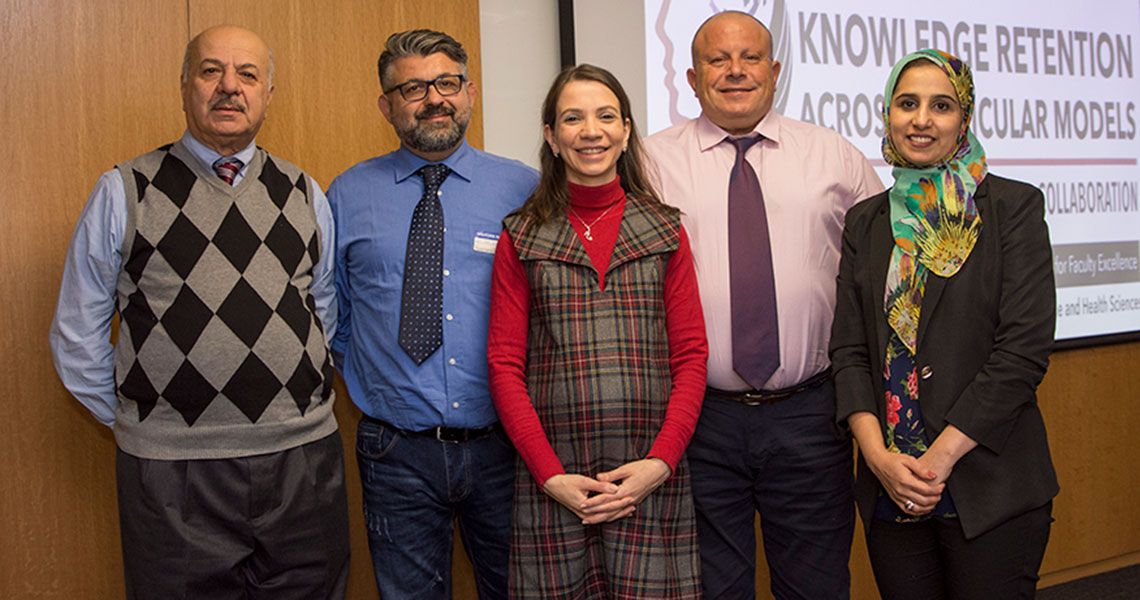For Rosalyn Jurjus, MD, PhD ’09, George Washington University (GW) School of Medicine and Health Sciences (SMHS) associate professor of anatomy and regenerative biology, a project to help with medical student knowledge retention of basic anatomy turned into something much larger than she ever imagined.
Jurjus, speaking at December’s Knowledge Retention Across Circular Models symposium, said she’s been working on the research for half a decade.
One day in 2011, during a GW Master Teacher Leadership Development Program class, fellow cohort members Juliet Lee, assistant professor of surgery at SMHS, and former professor Jill Krapf, MD, mentioned that by the time medical students reach surgical rotation, they don’t remember their anatomy lessons.
Jurjus couldn’t just leave it at that. “Let’s do something about it,” she said at the time. “So there was born six years of research, and now an international collaboration,” remarked Ellen Goldman, EdD, assistant dean for faculty and curricular development in medical education and professor of clinical research and leadership at SMHS, in her welcome at the symposium.
The symposium featured presentations by faculty members from the American University of Beirut (AUB), Lebanon; University of Balamand, Lebanon; University of Palermo, Italy; and the University College Cork (UCC), in Ireland.
“It was amazing to get everyone in one room,” Jurjus said. “That’s priceless for international collaboration. It took a lot of work and effort to make it happen, like coordinating schedules and all the logistics, but it was worth it.”
Jurjus first spoke about her research, which was conducted to test the assumption medical students have trouble retaining anatomy knowledge. Through surveying students on clinical rotation, she confirmed that knowledge retention is a major issue among medical students.
Her solution was a mini-curriculum added to the OB/GYN rotation. It included a baseline test of anatomy when students entered the rotation, online modules to help students remember basic anatomy, a hands-on gross anatomy session in the lab, and another test upon their completion of the rotation.
About 120 third-year students participated, and, Jurjus said, anatomy retention was improved among several areas of the body including the uterus, vasculature, and perineum, among others.
But, while the intervention is helpful, she said, it doesn’t completely solve the problem. “We will be promoting more integration of basic sciences into the clinical year,” she said. “The essential components are coordination between clinical sciences faculty and the basic sciences faculty; I’ve learned that this is critical.”

Following Jurjus’ talk, all four international presenters discussed anatomy education efforts at their educational institutions.
Abdo R. Jurjus, PhD, professor of anatomical sciences at AUB, adjunct professor of anatomy and regenerative biology at SMHS, and Rosalyn Jurjus’ father, described the changes he’s witnessed in medical education at the institution, and in the United States, throughout the past five decades.
He said the changes in education at AUB mirror those in most U.S. medical schools. In 2013, he said, AUB changed its curriculum to an integrated curriculum. The anatomy course, he added, is the only one maintained as a standalone course in the new curriculum.
Attendees also heard from Mutahira Lone, medical demonstrator in the Department of Anatomy and Neuroscience at UCC. Lone described gross anatomy education at UCC, which includes different modalities to provide an enhanced learning experience for students.
UCC plans to follow in SMHS’ footsteps by studying students’ memory retention via a questionnaire. The first set of data will be collected from students after they complete the genitourinary system in Year 2. The second set of data will be collected when the students start their clinical rotations, she noted.
In addition, Jihad Hawi, PhD, assistant professor at the University of Balamand Faculty of Medicine and Medical Sciences, spoke about his institution’s new integrated modular system, and Angelo Leone, PhD, professor of histology and embryology at the Medical and Dental School in Palermo, Italy, discussed the teaching of anatomy in Palermo.
At the end of the symposium, Rosalyn Jurjus said attendees took away not just a desire to build on the research happening at GW, but also connected on other issues to collaborate on.
“We’re all discussing one specific project and all of a sudden that project translated into applying to dental students at their different institutions, we’re planning an ultrasound workshop, we planning an introduction to virtual histology in Palermo,” she said. “The symposium, research-wise, was incredibly promising.”



